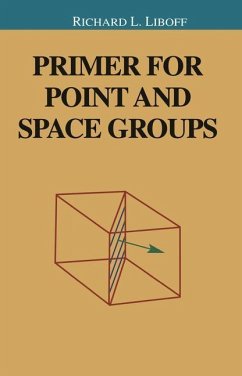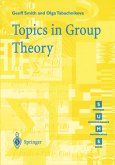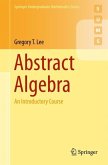This text stems from a course I have taught a number of times, attended by students of material science, electrical engineering, physics, chemistry, physical chemistry and applied mathematics. It is intended as an intro ductory discourse to give the reader a first encounter with group theory. The work concentrates on point and space groups as these groups have the principal application in technology. Here is an outline of the salient features of the chapters. In Chapter 1, basic notions and definitions are introduced including that of Abelian groups, cyclic groups, Sylow's theorems, Lagrange's subgroup theorem and the rearrangement theorem. In Chapter 2, the concepts of classes and direct products are discussed. Applications of point groups to the Platonic solids and non-regular dual polyhedra are described. In Chapter 3, matrix representation of operators are introduced leading to the notion of irreducible representations ('irreps'). The Great Orthogonal ity Theorem (GOT) is also introduced, followed by six important rules relating to dimensions of irreps. Schur's lemma and character tables are described. Applications to quantum mechanics are discussed in Chapter 4 including descriptions of the rotation groups in two and three dimensions, the symmetric group, Cayley's theorem and Young diagrams. The relation of degeneracy of a quantum state of a system to dimensions of irreps of the group of symmetries of the system are discussed, as well as the basis properties of related eigenfunctions.
From the reviews:
"I teach a course which involves symmetry and point groups so I was especially pleased to have been asked to do this review. ... The material is covered succinctly but in surprising depth for the size of the volume. ... The text is clear throughout and the nomenclature is consistent. ... It is more likely to provide a solid background for researchers and postgraduate students entering a new field or undergraduates dealing with advanced topics which are especially group theory intensive." (Contemporary Physics, Vol. 46 (4), July-August, 2005)
"This small volume may prove most useful to the lecturer in symmetry and/or group theory who will find many brief, interesting, and unusual ideas and approaches to many of different topics. ... The individual chapters are followed by interesting questions that are designed to extend the applications discussed in the chapter. ... Again these questions will surely prove useful to the lecturer for future lectures and exams!" (Gary J. Long, Fernande Grandjean, Physicalia, Vol. 57 (3), 2005)
"Liboff's book provides a general introduction to the subject with applications in quantum mechanics and solid state physics. ... A distinguishing feature of the book is the generous use of figures and illustrations ... . The book could be used in a short course on group theory or to supplement courses on quantum mechanics or solid state physics. It also provides a relatively painless introduction to the subject for those who need to learn it later in life." (Serdar Kuyucak, The Physicist, Vol. 41 (5), 2004)
"Written in the spirit of Liboff's text on quantum mechanics, the book is an introductory text for undergraduates in physics, engineering, materials science, and chemistry. With its selection and arrangement of examples, the book traces at every turn the physical implications of abstract concepts. It provides a solid background for those students who expect to use group theoryin nuclear and particle physics and other specific applications." (Zentralblatt für Didaktik der Mathematik, Mai, 2004)
"This text, a part of the series Undergraduate Texts in Contemporary Physics, is intended as an introductory book on group theory for undergraduates in materials science, electrical engineering, physics, chemistry, physical chemistry, and applied mathematics. ... Overall, this text will probably be useful as a reference to those in physics, materials science, and applied mathematics ... . The text would be ... useful for those involved in the advanced study of solid state materials, as this tends to be the focus of the work." (Christopher Stromberg, Theoretical Chemistry Accounts, Vol. 115 (1), 2006)
"I teach a course which involves symmetry and point groups so I was especially pleased to have been asked to do this review. ... The material is covered succinctly but in surprising depth for the size of the volume. ... The text is clear throughout and the nomenclature is consistent. ... It is more likely to provide a solid background for researchers and postgraduate students entering a new field or undergraduates dealing with advanced topics which are especially group theory intensive." (Contemporary Physics, Vol. 46 (4), July-August, 2005)
"This small volume may prove most useful to the lecturer in symmetry and/or group theory who will find many brief, interesting, and unusual ideas and approaches to many of different topics. ... The individual chapters are followed by interesting questions that are designed to extend the applications discussed in the chapter. ... Again these questions will surely prove useful to the lecturer for future lectures and exams!" (Gary J. Long, Fernande Grandjean, Physicalia, Vol. 57 (3), 2005)
"Liboff's book provides a general introduction to the subject with applications in quantum mechanics and solid state physics. ... A distinguishing feature of the book is the generous use of figures and illustrations ... . The book could be used in a short course on group theory or to supplement courses on quantum mechanics or solid state physics. It also provides a relatively painless introduction to the subject for those who need to learn it later in life." (Serdar Kuyucak, The Physicist, Vol. 41 (5), 2004)
"Written in the spirit of Liboff's text on quantum mechanics, the book is an introductory text for undergraduates in physics, engineering, materials science, and chemistry. With its selection and arrangement of examples, the book traces at every turn the physical implications of abstract concepts. It provides a solid background for those students who expect to use group theoryin nuclear and particle physics and other specific applications." (Zentralblatt für Didaktik der Mathematik, Mai, 2004)
"This text, a part of the series Undergraduate Texts in Contemporary Physics, is intended as an introductory book on group theory for undergraduates in materials science, electrical engineering, physics, chemistry, physical chemistry, and applied mathematics. ... Overall, this text will probably be useful as a reference to those in physics, materials science, and applied mathematics ... . The text would be ... useful for those involved in the advanced study of solid state materials, as this tends to be the focus of the work." (Christopher Stromberg, Theoretical Chemistry Accounts, Vol. 115 (1), 2006)









